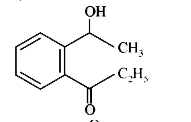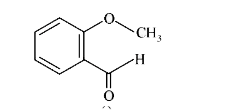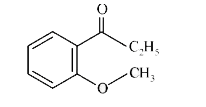A compound X neither reacts with soidum displacing hydrogen nor with PCl5 to give HCl X reduces an alkaline solution of Cu (II) salt on gentle warming. The structure of X is
primary alcohol
secondary alcohols
a ketone
an aldehyde
The correct Answer is:D
Step by step video, text & image solution for A compound X neither reacts with soidum displacing hydrogen nor with PCl_(5) to give HCl X reduces an alkaline solution of Cu (II) salt on gentle warming. The structure of X is by Chemistry experts to help you in doubts & scoring excellent marks in Class 12 exams.
Updated on:21/07/2023Topper's Solved these Questions
- ALDEHYDES AND KETONES BOOK - OP TANDONCHAPTER - ALDEHYDES AND KETONES EXERCISE - OBJECTIVE QUESTIONS (LEVEL -B) SET I
38 Videos
- ALDEHYDES AND KETONES BOOK - OP TANDONCHAPTER - ALDEHYDES AND KETONES EXERCISE - OBJECTIVE QUESTIONS (LEVEL -B) SET II
36 Videos
- ALDEHYDES AND KETONES BOOK - OP TANDONCHAPTER - ALDEHYDES AND KETONES EXERCISE - BRAIN STORMIN PROBLEMS
13 Videos
- ALCOHOLS, PHENOLS AND ETHERSBOOK - OP TANDONCHAPTER - ALCOHOLS, PHENOLS AND ETHERSEXERCISE - SINGLE INETER ANSWER TYPE QUESTIONS / ALCOHOLS AND PHENOLS
15 Videos
- BASIC PRINCIPLESBOOK - OP TANDONCHAPTER - BASIC PRINCIPLESEXERCISE - SECTION V INTEGER ANSWER TYPE QUESTION
3 Videos
Similar Questions
An aliphatic compound (A) with a molecular formula C3H6O reacts with phenylhydrazine to give compound (B). Reaction of (A) with I2 in alkaline solution on warming gives a yellow precipitate (C). Identify the compounds A, B and C.
View SolutionA compound (A) is greenish crystalline salt, which gave the following reactions.
(i)Addition of BaCl2 solution to the solution of (A) results in the formation of white precipitate (B) which is insoluble in dilute HCl.
(ii)On heating (A), water vapours and two oxides of sulphur (C) and (D) are liberated leaving a red brown residue (E).
(iii)(E) dissolves in warm concentrated HCl to give a yellow solution (F).
(iv)Solution (F) on treatment with thiocyanate ions gives blood red coloured compound (G).
Identify the compounds from (A) to (G).
View Solution
Knowledge Check
An organic compound X reacts with sodium metal and evolve hydrogen gas, on oxidation of X by PCC give aldehyde. The formula of X could be
A(CH3)2CH−OHBCH3−CH2−OHC(CH3)C−OHDCH3−CHOHC2H5The compound 'X' upon alkaline hydrolysis gives a product which reacts with phenylhydrazine butdoes not reduce ammoniacal silver nitrate solution. A possible structure for 'X' is
ACH3CHClCH2ClBCH3CCl2CH3CCH3CH2CH2ClDCH3CH2CHCl2An organic compound neither reacts with neutral ferric chloride solution nor with Fehling solution. It however, reacts with Grignard reagent and gives positive iodoform test. The compound is
A B
B C
C D
D
An organic compound 'X' on treatment with pyridinium chlorochromate in dichloromethane gives compound 'Y'. Compoun 'Y', reacts with I2 and alkali to form tri-iodomethane. The compound 'X' is :
View SolutionA colourless liquid A(b.p.184∘C) is sparingly soluble in warm water to which it gives feebly alkaline. On treating with NaNO2 and dil HCl in the cold solution, it yields a solution which reacts with an alkaline solution of β-naphthol to give an orange yellow precipitate. Compound A is -
View SolutionOxidation of a compound X gives a product which react with phenyl hydrazine but does not give silver mirror test . The structure of X is
View SolutionWhich of the following hydrogen halides react with AgNO3 to give a precipitate that dissolves in hypo solution ?
(I)HCl (II)HF (III)HI (IV)HBr
View SolutionA natural compound (X). C4H8O2. Rduces Fehling's solution , liberates hydrogen when treated with sodium metal and gives a positive iodoform test. The structure of (X) is:
View Solution
